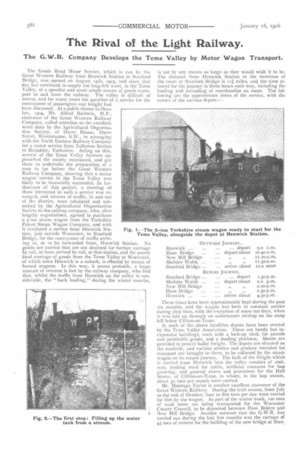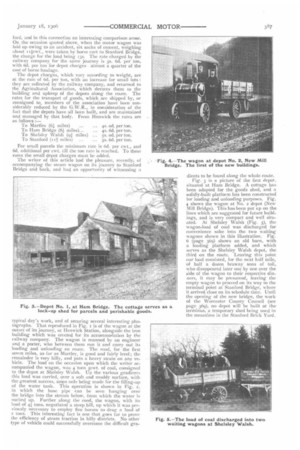The Rival of the Light Railway.
Page 24

Page 25

If you've noticed an error in this article please click here to report it so we can fix it.
The G.W.R. Company Develops the Teme Valley by Motor Wagon
The Goods Road Motor Service, which is run by ibe Great Western Railway from Henwick Station to Stanford Bridge, was opened on August talah, inos, and since that day has continued to supply the long-felt want, in the Teme Valley, of a speedier and more ample means of goods transport to and from the railway. The valley is difficult of access, and for many years the question of a service for the conveyance of passengers and freight had been discussed. At a public dinner in October, 1934, Mr. Alfred Baldwin, M.P., chairman of the Great Western Railway Company, called attention to the excellent work done by the Agricultural Organisation Society, of Dacre House, Daere Street, Westminster, S.W., in arranging, with the North Eastern Railway Company for a motor service from ToBerton Station to Brandsby, Yorkshire. Acting on this, several of the Teme Valley farmers approached the society mentioned, and got them to undertake the preparation of it case to lay before the Great Western Railway Company, showing that a motor wagon service in the Teme Valley was likely to be financially successful. In furtherance of this project, a meeting of those interested in such a service was arranged, and returns of traffic, in and out of the district, were tabulated and submitted by the Agricultural Organisation Society to the railway company, who, after lengthy negotiations, agreed to purchase a 5-ton steam wagon from the Yorkshire Patent Steam Wagon Company, and with
it instituted a service from Henwick StaFig. tion, just outside Worcester, to Stanford Bridge, for the conveyance a traffic arriv
ing at, or to be forwarded from, Henwick Station. No goods are carried that are not destined for further carriage by rail, or have arrived by rail, at that station, and the purely local carriage of goods from the Tome Valley to Worcester, of which town Henwick is a suburb, is effected by means of horsed wagons. In this way, it seems probable, a large amount of revenue is lost by the railway company, who find that, whilst the traffic from Renwick up the valley is considerable, the " back loading," during the winter months, is not by any means as large as they would wish it to be. The distance from Henwick Station to the terminus of the route at Stanford Bridge is IQ miles, and the time allowed for the journey is three hours each way, including the loading and unloading of merchandise en route. The following are the approximate timers of the service, with the names of the various depots :— These times have been approximately kept during the past six months, and the wagon has been in constant service during that time, with the exception of some ten days, when it was laid up through an unfortunate mishap on the steep hill below Clifton-on-Teme.
At each of the above localities depots have been erected by the Teme Valley Association. These are handy but inexpensive buildings, each with a lock-up shed, for parcels and perishable goods, and a loading platform. Sheets are provided to protect bulky freight. The depots are situated on the roadside, and various articles and produce intended for transport are brought to them, to be collected by the steam wagon on its return journey. The bulk of the freight which is carried from Henwick into the valley consists of coal, oats, feeding meal for cattle, artificial manures for hop growing, and general stores and provisions for the Hall Stores, of Clifton-on-Teme, to whom, in the hop. season, about so tons per month were carried.
Mr. Montagu Taylor is another excellent customer of the Great Western Railway. During the fruit season, from July to the end of October, four to five tons per day were carried for him by the wagon. As part of the winter work, 100 tons of road stone are being transported for the Worcester County Council, to be deposited between Ham Bridge and New Mill Bridge. Another contract that the G.W.R. has carried out during the last few months was the cartage of 45 tons of cement for the building of the new bridge at Stan
ford, and in this connection an interesting comparison arose. On the occasion quoted above, when the motor wagon was laid up owing to an accident, six sacks of cement, weighing about ii/cwt., were taken by horse cart to Stanford Bridge, the charge for the load being 135. The rate charged by the railway company for the same journey is ss. 6d. per ton. with 6d. per ton for depot charges almost a quarter of the cost of horse haulage.
The depot charges, which vary according to weight, are at the rate of 6d. per ton, with an increase for small lots : they are collected by the railway company, and returned to the Agricultural Association, which devotes them to the building and upkeep of the depots along the route. The rates for the transport of goods, which are shipped by, or consigned to, members of the association have been considerably reduced by the G.W.R., in consideration of the fact that the depots have all been built, and are maintained and managed by that body. From Henwick the rates are as follows :—
To Martlev (6;t miles) ... 4s. od. per ton.
To Ham Bridge (8i miles)... ... 4s. 6d. per ton. To Shelsley Walsh (91 miles) ... ss. od. per ton.
To Stanford (1 11 miles) ... .... 5s. 6d. per ton.
For small parcels the minimum rate is (id. per cwt., and 6d. additional per cwt. till the ton rate is reached. To these rates the small depot charges must be added. The writer of this article had the pleasure, recently, of accompanying the steam wagon on its journey to Stanford Bridge and back, and had an opportunity of witnessing a
typical day's work, and of securing several interesting photographs. That reproduced in Fig. i is of the wagon at the outset of its journey, at Henwick Station, alongside the iron building which was erected for its accommodation by the railway company. The wagon is manned by an engineer and a porter, who between them run it and carry out. its loading and unloading en route. The road, for the first seven miles, as far as Martley, is good and fairly level ; the remainder is very hilly, and puts a heavy strain on any vehicle. The load on the occasion upon which the writer accompanied the wagon, was 4-tons scwt. of coal, consigned to the depot at Shelsley Walsh. Up the various gradients this load was carried, over a soft and muddy surface, with the greatest success, stops only being made for the filling-up of the water tank. This operation is shown in Fig. 2, in which the hose pipe can be seen hanging over the bridge into the stream below, from which the water is sucked up. Further along the road, the wagon, with its load of 4.1, tons, negotiated a steep hill, up which it was previously necessary to employ five horses to drag a load of 2 tons. This interesting fact is one that goes far to prove the efficiency of steam traction in hilly districts. No other type of vehicle could successfully overcome the difficult gra
dients to be found along the whole route. Fig. 3 is a picture of the first depot. situated at Ham Bridge. A cottage has been adapted for the goods shed, and a solidly-built platform has been constructed tor loading and unloading purposes. Fig. 4 shows the wagon at No. 2 depot (New Mill Bridge). This has been put up on the lines which are suggested for future buildings, and is very compact and well situated. At Shelsley Walsh (Fig. 5), the wagon-load of coal was discharged for convenience sake into the two waiting wagons shown in this illustration. Fig. 6 (page 369) shows an old barn, with a loading platform added, and which serves as the Shelsley Walsh depot, the third on the route. Leaving this point our load consisted, for the next half mile, of half a dozen brawny sons of toil, who disappeared later one by one over the side of the wagon to their respective dinners, it may be presumed, leaving the empty wagon to proceed on its way to the terminal point at Stanford Bridge, where it arrived close on its schedule time. Until the opening of the new bridge, the work of the Worcester County Council (see page 369), no depot will he built at the terminus, a temporary shed being used in the meantime in the Stanford Brick Yard.


























